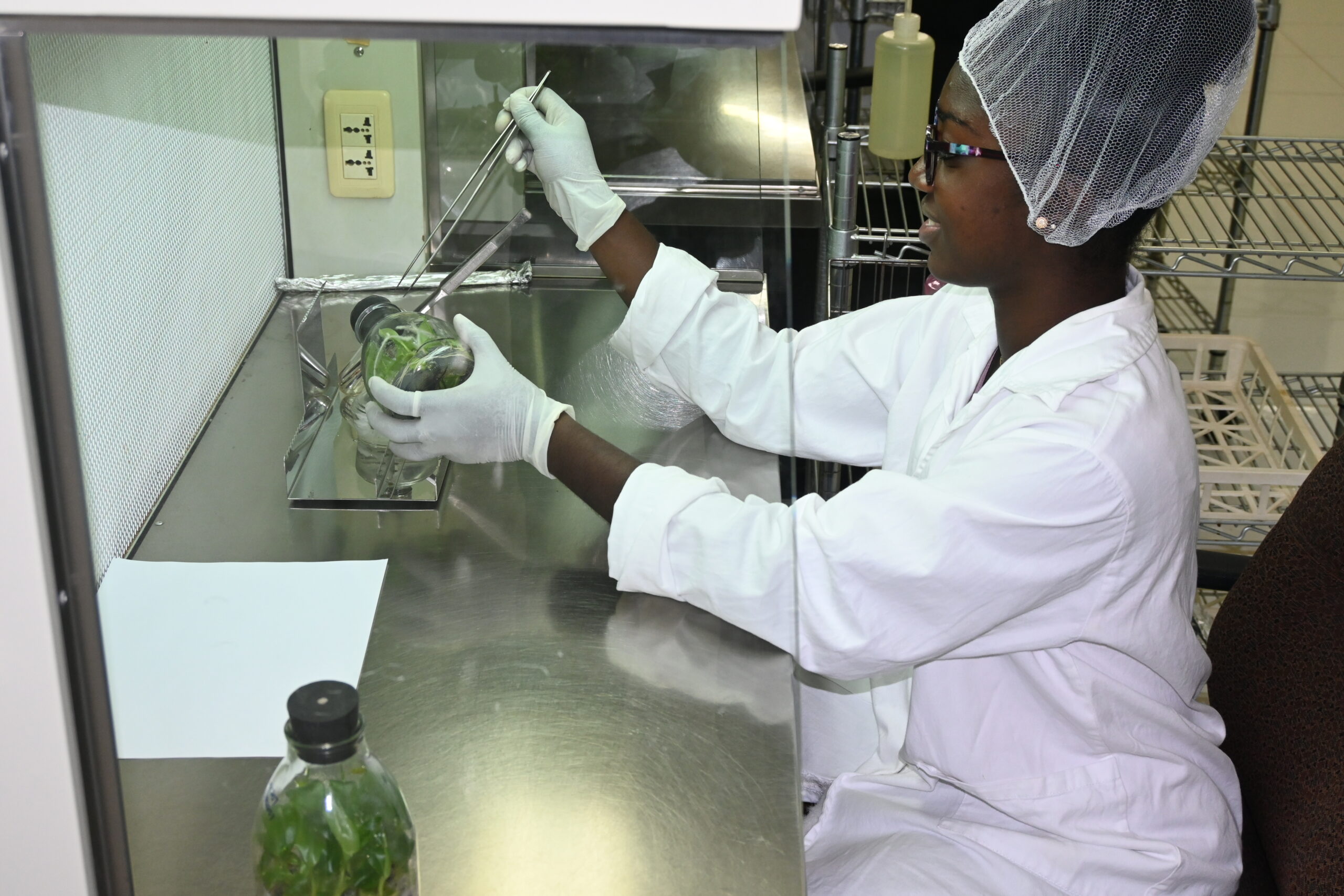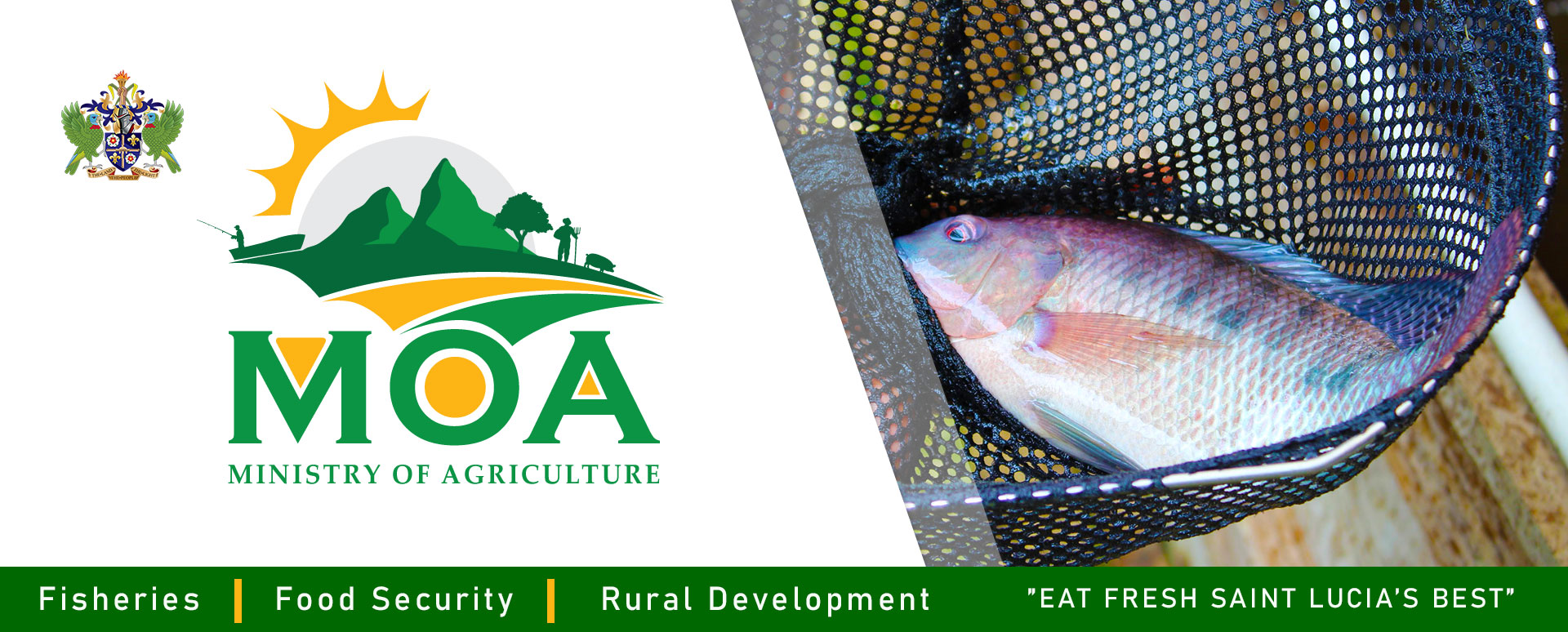TISSUE CULTURE
The Tissue Culture Laboratory of the Ministry of Agriculture, Lands, Agricultural and Forestry & Fisheries is located at the Union Agricultural Station and is a sub-unit of the propagation division. The need for producing plants via Tissue Culture in Saint Lucia is a consequence of the high demand for quality planting material and the urgency of diversifying the local agricultural products. In addition, the government over the past few years has spent heavily on the importation of tissue culture plantlets produced in Israel to revitalize the then ailing banana industry. It is against this background that the Government of the Republic of China (Taiwan) has generously financed the construction of a modern plant tissue culture laboratory on the grounds of the Union Agricultural Station. This new facility has the capacity to produce well over five hundred thousand (500,000) plantlets per year of various food, root, fruit crop species, ornamentals, and possibly forest species of economic and/or ecological importance.
Mr. Winsbert Pierre Louis
Officer in Charge - Horticulturist
Playlist
OBJECTIVES
The objectives of the Tissue Culture Laboratory include the strengthening of the biotechnological capabilities of the ministry of agriculture in the areas of plant micropropagation, investigative research, identification and creation of genetically modified organisms, germplasm conservation, public education and sensitization in relevant areas, and student career preparation/ guidance in plant tissue culture and plant biotechnology.
VISION
To make available to the farming community and wider society quality food & ornamental planting material. Provision of analytical services and support to the biosafety unit in the field of risk assessment of genetically modified organisms (GMOs) and serve as a regional plant tissue culture center for training of regional experts.
PROJECTS
Click the links below to read more
- Mango Grafting Manual
- Technologies developed Citrus
- Supporting the Control and Prevention of Citrus Greening in Saint Lucia
- Barrett-IICA mission report St Lucia-btrv (1)
- Conservation of Black Sigatoka tolerant Musa Spp
- Opening - ICC Presentation - Santo 30 Oct 2019
- Orchid Pests and Diseases, Diagnosis, Treatment and Prevention
- Tissue Culture Methods Applied for Banana and Plantain Propagation_JanaySerejo-1-1
- Strawberry Tissue Culture
- Manual for Hardening Tissue Culture Bananas
- Needed item for STG-Citrus Greening RRA
- New Banana Media
- TCP-Supporting the Control and Prevention of Citrus Greening in SLU
FREQUENTLY ASKED QUESTIONS
Orchids are not as difficult to care for as some people fear; they are just different from other houseplants. As epiphytes, their roots need air circulation and moisture. Use an orchid growing medium instead of soil and replant with new medium as needed. The medium will break down with time, so keep an eye on it. Water your orchid plant about once a week by soaking the roots in the sink. Use a fertilizer once weekly as well. Place an orchid in a sunny spot and keep the air around it humid by setting the pot on a tray of pebbles filled with water.
Most orchid plants need to be watered once a week. When the growing medium is dry for about an inch down or lower, the plant needs watering. When watering, really soak the roots. Put the container in the sink and let water run over and soak the roots several times.
The most important factor in choosing a container for orchids is drainage. The roots need to be wet most of the time but not sitting in water, so a pot with drainage holes is an absolute must. Any kind of material is fine, but the best type of pot for an orchid is clear or translucent plastic. In the wild, orchids grow with their roots exposed to air and light, so this allows some light to get through to them.
Orchids need water soluble fertilizer because they don’t grow in soil. A balanced fertilizer or one designed specifically for orchids will work. Use fertilizer at least once a month but up to once weekly. Mix the fertilizer with water as described on the package instructions and use it to water the plant by soaking the roots.
Orchids need water soluble fertilizer because they don’t grow in soil. A balanced fertilizer or one designed specifically for orchids will work. Use fertilizer at least once a month but up to once weekly. Mix the fertilizer with water as described on the package instructions and use it to water the plant by soaking the roots.
Orchids need water soluble fertilizer because they don’t grow in soil. A balanced fertilizer or one designed specifically for orchids will work. Use fertilizer at least once a month but up to once weekly. Mix the fertilizer with water as described on the package instructions and use it to water the plant by soaking the roots.
Pests on orchid plants can be frustrating but easily remedied in most cases. Mealybugs are immobile and will grow covers over themselves on the leaves of orchids. Gently scrape these off to begin, and then use a gentle pesticide to treat your plant until the pest is completely gone. Use neem oil in warm water or an insecticidal soap once a week.
Orchids often grow new roots that emerge from the container; these are called tendrils or air roots. As epiphytes, it is natural for orchids to have roots exposed to the air. They absorb moisture and nutrients from the air. Healthy tendrils are firm and whitish in color. These should not be removed. They are healthy and normal. Dry, dead, or diseased tendrils can be removed with a clean, sharp tool.
There are two reasons to repot an orchid: when the roots start growing outside the container and when the growing medium has broken down too much. The latter causes the medium to become denser, preventing roots from getting needed airflow. Depending on the orchid and its growing conditions, it may need to be repotted as often as every six months or as little as every three years. Use a slightly larger pot, brand new medium, and move the orchid when it is not flowering. Clean and soak the roots before putting in the new pot.
Absolutely not! Of the approximately 20,000 species of orchids that grow around the world, not one is parasitic. In nature, many orchids cling to trees and bushes as a growth habit, but they take nothing from the host plant and do not injure it in any way. Orchids that grow on trees are called epiphytes or air plants.
Are orchids short-lived?
Most are long-lived. In fact, some species are virtually immortal, given the proper attention. Divisions or propagations of orchids discovered in the 19th century are still growing and flowering today.
It depends on the type as well as on cultural treatment. Blooms of hybrids of the genus Cattleya may last from one to four weeks on the plant. Those of the genus Phalaenopsis commonly last from one to four months
Some are so powerfully scented as to perfume an entire greenhouse or living room. A few orchid fragrances defy description, while others mimic familiar aromas — raspberry, coconut, lilacs and citrus. Others have no scent, but rely on shape and color to attract insects or birds for pollination, thereby continuing the life cycle of the species.
DESCRIPTION
Plant Tissue Culture is a very broad and multifaceted field. It is a technological application that can be used by the curious gardener multiplying plants in a modest home kitchen to the renowned scientist working in an elaborate laboratory. It is used for the propagation of plants under germ-free conditions often to produce exact replicas of a plant. Tissue culture relies on the fact that many plant cells can produce a whole plant from single cells, plant cells without cell walls (protoplasts), pieces of leaves or roots, these can be used to generate a new plant on culture media given the required nutrients and plant hormones are present.
Tissue Culture produced plants present several advantages:
- The production of exact copies of plants that produce particularly good flowers, fruits, or have other desirable traits.
- To quickly produce mature plants.
- The production of multiples of plants in the absence of seeds or necessary pollinators to produce seeds.
- The regeneration of whole plants from plant cells that have been genetically modified.
- The production of plants in germ-free conditions allow them to be moved with greatly reduced chances of transmitting diseases, pests, and pathogens.
- The production of plants from seeds that otherwise have very low chances of germinating and growing, i.e. orchids etc.
- To clean particular plants of viral and other infections and to quickly multiply these plants as cleaned stock for agriculture and horticulture.

OUR TEAM





CONTACT US
- Winsbert Pierre Louis
- Phone: 486 6800
- Cell: 758-719 9117
- Email: wpierrelouis@gmail.com





